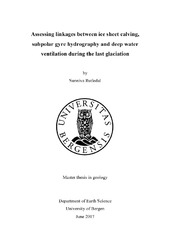| dc.description.abstract | It is commonly postulated that ice sheet dynamics and freshwater perturbations in the North Atlantic were linked to disruptions in deep water circulation and North Atlantic cooling in the past. However, the exact nature of climate-ocean-ice sheet coupling remains unclear and increased iceberg activity and freshwater pulses have been hypothesized as both the trigger for, and response to, reduced Atlantic Meridional Overturning Circulation (AMOC). Differentiating between these hypotheses requires high-resolution records constraining the relative timing of ice sheet calving, freshwater perturbations and ocean circulation changes. Here I assess the relative timing and linkages between iceberg discharge, subpolar gyre hydrography, and deep water ventilation in the North Atlantic using proxy records co-registered in the same sediment sequence. High-resolution ice rafted debris (IRD) and stable isotope (δ^18O and δ^13C) records of planktonic (N. pachyderma (s)) and benthonic (C. wuellerstorfi) foraminifera were generated in sediment core GS15-196-02GC from the Irminger basin (59°37.1 N, 40°44.25 W, 2468 m water depth). The records document a clear coupling between increasing iceberg influence (IRD), decreasing deep water ventilation (benthonic δ^13C), and temperature and salinity changes in the subpolar gyre surface waters (planktonic δ^18O). The largest IRD peaks are coincident with low planktonic δ^18O anomalies and are associated in time with Heinrich events 1-3. However, low magnetic susceptibility, low Ca/Sr (detrital carbonate), and increases in Si/Sr (detrital silicate) indicate that the IRD layers associated with H1-H3 do not have the properties of typical Hudson Strait/Laurentide Ice sheet (LIS) sourced material; implying that other ice sheets were also active at these times. The proximity of the core to southeast Greenland and the East Greenland Current (EGC) points towards an IRD origin from east Greenland or other circum-Nordic Seas sources. The benthonic (C. wuellerstorfi) δ^13C record documents high magnitude variability in deep ocean ventilation throughout the last glacial and deglacial periods. Intervals of peak subpolar gyre freshening (planktonic δ^18O minima) were preceded by ‘precursor' increases in iceberg discharge and decreases in deep water ventilation (benthonic δ^13C). These ‘precursors’ were initiated 500-2000 years prior to the H2 and H3 related freshening, supporting the hypothesis that reduced AMOC was important for triggering ice shelf melting/collapse during Heinrich events. However, the periods of weakest ventilation (low benthonic δ^13C) still coincide with the largest IRD peaks and planktonic δ^18O decreases, consistent with a feedback of ice sheet collapse and subpolar freshening on deep water circulation. Finally, there is preliminary evidence that circum-Nordic Seas iceberg calving may also have increased during smaller (non- Heinrich) Dansgaard-Oeschger stadials. Taken together, the results point toward a two-way coupling between ocean circulation and ice sheets during millennial scale climate changes and highlight the systematic involvement, and potential sensitivity, of the circum-Nordic Seas cryosphere-ocean system. | en_US |
